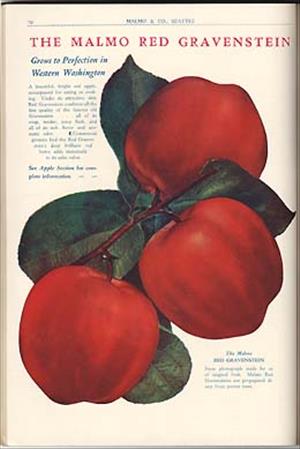This note on the luscious Seattle nurseries of Charles Malmo is based on the extensive collection of photographs, newspaper clippings, and catalogs on Malmo's firm found in the library of Seattle's Museum of History & Industry (MOHAI). It was prepared by MOHAI historian Lorraine McConaghy, Ph.D.
Charles Malmo was born in Norway, and immigrated to the United States in 1878, coming to Seattle in 1891. Two years later -- in 1893 -- he founded the first Malmo nursery and opened the first Malmo seed store at 916 2nd Avenue in Seattle. Malmo claimed to be the first nurseryman in the Pacific Northwest to propagate nursery stock of ornamental shrubs, which had previously been imported from Japan, Holland, and England.
In 1923, Malmo & Company was 30 years old, and sold seeds and nursery stock from its corner store on Seattle's 6th Avenue and Stewart Street, at Westlake. The 1923 planting guide offered plants from the Malmo rhododendron field and greenhouses in Georgetown, and invited visitors to take the local interurban train down to Chicago Street, to visit the rhodies at “blossom time,” in late May. As Malmo’s seed catalog described the Georgetown facilities:
You will find our trees, evergreens and shrubs growing in well-prepared soil in our nursery at Georgetown, or at our large sales yard, a block from our store ... . We grow all kinds of nursery stock extensively at our Georgetown nursery and invite our customers to inspect the same. When in full bloom, our field of several thousand rhododendrons presents a massive floral display of over 100,000 blossoms in fifteen different shades and colors.
The Malmo catalog also encouraged local homeowners to plant vegetable gardens and orchards in their small back yards, noting “the Puget Sound climate is adapted to the growing of both sweet and sour cherries, pears and many varieties of apples, including Yellow Transparent and Gravenstein ... . A few fruit trees in the garden or back yard may be made to yield a high return ... [with vegetables] planted between the trees.”
The 1923 Malmo catalog offered 10 Bartlett pear trees, four to six feet in height, for $9.00, and Gravenstein, Yellow Transparent, Jonathan, and Winesap – among dozens of apple varieties -- at 10 trees for $7.50. Cumberland raspberry starts cost $1.50 for a dozen plants. Malmo offered a wide variety of tulip, daffodil, narcissus, and hyacinth bulbs, all imported from Holland, as well as many named varieties of rhododendrons and roses. Malmo sold packets of flower seed from Asters to Zinnias, including a dozen varieties of pansies, snapdragon, and phlox.
Home vegetable gardeners bought some varieties familiar to today’s backyard gardeners, including Kentucky Wonder pole beans at a pound of seed for 30 cents, and Chantenay carrots at a pound of seed for $1.25. Then, as now, gardeners west of the Cascades were discouraged from planting watermelons, honey dew melons, and most larger tomato varieties because of Puget Sound’s cool, shady summers. However, Malmo confidently sold Connecticut Seed Leaf tobacco, at $5 per pound, advising that local soil be amended with wood ashes.
Seven years later -- in 1930 -- Malmo opened Garden Square at Westlake and 6th, at Virginia Street, in Seattle's new Denny Regrade area. Intended to be a full-service urban garden center, Garden Square replaced street-level plate glass windows with wrought iron gates, to open the gardens to passersby. Reporters enthused about the ground-floor “open-air garden” with its rich foliage and glorious blooms, and the elaborate roof garden for sun-loving plants. In 1930, Malmo still maintained 25 acres of greenhouses and fields in Georgetown, adjacent to Boeing Field. In 1937, Charles Malmo’s son Clark Malmo purchased 30 acres at the present site of University Village, and the firm continued to flourish until its purchase in 1962 by Ernst Hardware and Pay 'n' Save stores.

